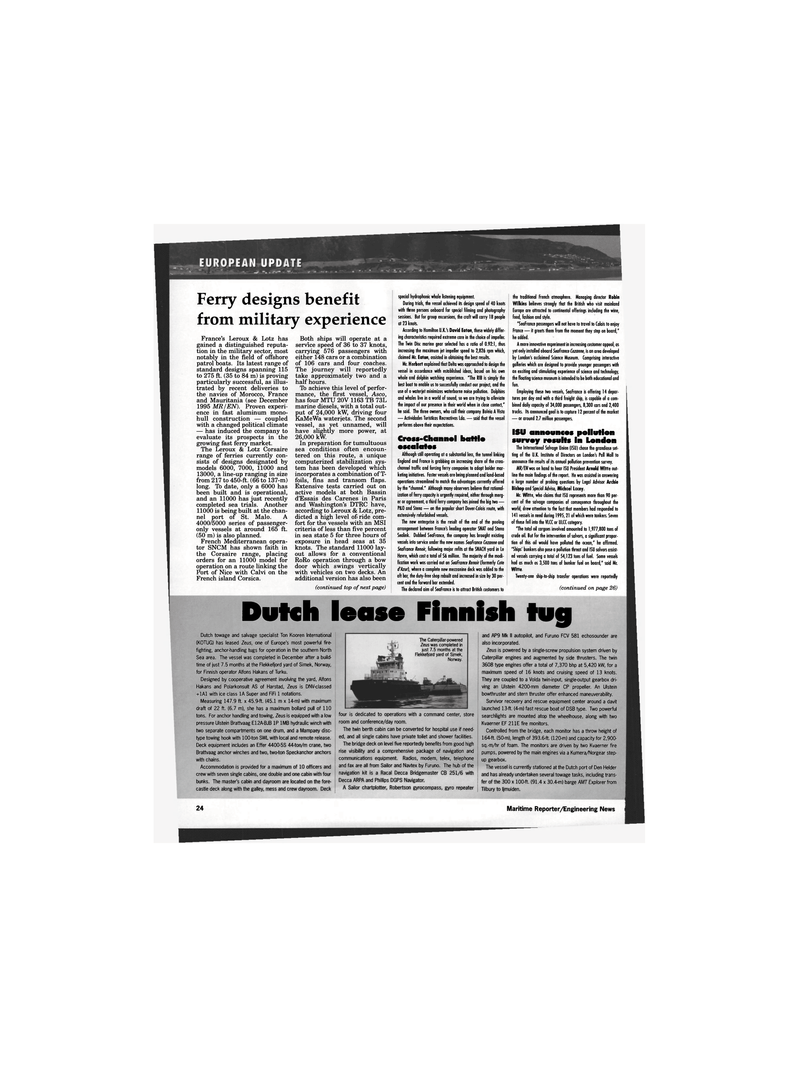
Page 22: of Maritime Reporter Magazine (June 1996)
Read this page in Pdf, Flash or Html5 edition of June 1996 Maritime Reporter Magazine
Ferry designs benefit from military experience
France's Leroux & Lotz has gained a distinguished reputa- tion in the military sector, most notably in the field of offshore patrol boats. Its latest range of standard designs spanning 115 to 275 ft. (35 to 84 m) is proving particularly successful, as illus- trated by recent deliveries to the navies of Morocco, France and Mauritania (see December 1995 MR/EN). Proven experi- ence in fast aluminum mono- hull construction — coupled with a changed political climate — has induced the company to evaluate its prospects in the growing fast ferry market.
The Leroux & Lotz Corsaire range of ferries currently con- sists of designs designated by models 6000, 7000, 11000 and 13000, a line-up ranging in size from 217 to 450-ft. (66 to 137-m) long. To date, only a 6000 has been built and is operational, and an 11000 has just recently completed sea trials. Another 11000 is being built at the chan- nel port of St. Malo. A 4000/5000 series of passenger- only vessels at around 165 ft. (50 m) is also planned.
French Mediterranean opera- tor SNCM has shown faith in the Corsaire range, placing orders for an 11000 model for operation on a route linking the
Port of Nice with Calvi on the
French island Corsica.
Both ships will operate at a service speed of 36 to 37 knots, carrying 576 passengers with either 148 cars or a combination of 106 cars and four coaches.
The journey will reportedly take approximately two and a half hours.
To achieve this level of perfor- mance, the first vessel, Asco, has four MTU 20V 1163 TB 73L marine diesels, with a total out- put of 24,000 kW, driving four
KaMeWa waterjets. The second vessel, as yet unnamed, will have slightly more power, at 26,000 kW.
In preparation for tumultuous sea conditions often encoun- tered on this route, a unique computerized stabilization sys- tem has been developed which incorporates a combination of T- foils, fins and transom flaps.
Extensive tests carried out on active models at both Bassin d'Essais des Carenes in Paris and Washington's DTRC have, according to Leroux & Lotz, pre- dicted a high level of ride com- fort for the vessels with an MSI criteria of less than five percent in sea state 5 for three hours of exposure in head seas at 35 knots. The standard 11000 lay- out allows for a conventional
RoRo operation through a bow door which swings vertically with vehicles on two decks. An additional version has also been (continued top of next page) special hydrophonic whale listening equipment.
During trials, the vessel achieved its design speed of 40 knots with three persons onboard for special filming and photography sessions. But for group excursions, the craft will carry 18 people at 23 knots.
According to Hamilton U.K.'s David Eaton, these widely differ- ing characteristics required extreme care in the choice of impeller.
The Twin Disc marine gear selected has a ratio of 0.92:1, thus increasing the maximum jet impeller speed to 2,826 rpm which, claimed Mr. Eaton, assisted in obtaining the best results.
Mr. Herbert explained that Delta was approached to design the vessel in accordance with established ideas, based on his own whole and dolphin watching experience. "The RIB is simply the best boat to enable us to successfully conduct our project, and the use of o waterjet minimizes waterborne noise pollution. Dolphins and whales live in a world of sound, so we are trying to alleviate the impact of our presence in their world when in close contort," he said. The three owners, who call their company Baleia A Vista — Actividades Turisticas Recreativas Lda. — said that the vessel performs above their expectations.
Cross-Channel battle escalates
Although still operating at a substantial loss, the tunnel linking
England and France is grabbing an increasing share of the cross- channel traffic and forcing ferry companies to adopt bolder mar- keting initiatives. Faster vessels are being planned and land-based operations streamlined to match the advantages currently offered by the "chunnel." Although many observers believe that rational- ization of ferry capacity is urgently required, either through merg- er or agreement, a third ferry company has joined the big two —
P&O and Siena — on the popular short Dover-Calais route, with extensively refurbished vessels.
The new enterprise is the result of the end of the pooling arrangement between France's lending operator SNAT ond Stena
Sealink. Dubbed SeaFrance, the company has brought existing vessels into service under the new names SeaFrance Cezanne and
SeaFrance Renoir, following major refits at the SNACH yard in Le
Havre, which cost a total of S6 million. The majority of the modi- fication work wos carried out on SeaFrance Renoir (formerly Co/e d'Azur), where a complete new mezzanine deck was added to the aft bar, the duty-free shop rebuilt and increased in size by 30 per- cent and the forward bar extended.
The declared aim of SeaFrance is to attract British customers to the traditional French atmosphere. Managing director Robin
Wilkins believes strongly that the British who visit mainland
Europe are attracted to continental offerings including the wine, food, fashion and style. "SeaFrance passengers will not have to travel to Calais to enjoy
France — it greets them from the moment they step on board," he added.
A more innovative experiment in increasing customer appeal, as yet only installed aboard SeaFrance Cezanne, is an area developed by London's acclaimed Science Museum. Comprising interactive galleries which are designed to provide younger passengers with an exciting and stimulating experience of science and technology, the floating science museum is intended to be both educational and fun.
Employing these two vessels, SeaFrance is offering 14 depar- tures per doy ond with a third freight ship, is capable of a com- bined daily capacity of 34,000 passengers, 8,300 cars and 2,400 trucks. Its announced goal is to capture 12 percent of the market — or around 2.7 million passengers.
ISU announces pollution survey results in London
The International Salvage Union (ISU) chose the grandiose set- ting of the U.K. Institute of Directors on London's Pall Mall to announce the results of its annual pollution prevention survey.
MR/EN wos on hand to hear ISU President Arnold Witte out- line the moin findings of the report. He was assisted in answering a large number of probing questions by Legal Advisor Archie
Bishop and Special Adviso, Michael Lacey.
Mr. Witte, who claims that ISU represents more than 90 per- cent of the salvage companies of consequence throughout the world, drew attention to the fact that members had responded to 141 vessels in need during 1995,21 of which were tankers. Seven of these fell into the VLCC or ULCC category. "The total oil cargoes involved amounted to 1,977,800 tons of crude oil. But for the intervention of salvors, a significant propor- tion of this oil would have polluted the ocean," he affirmed. "Ships' bunkers also pose a pollution threat and ISU salvors assist- ed vessels carrying a total of 54,123 tons of fuel. Some vessels had as much os 3,500 tons of bunker fuel on board," said Mr.
Witte.
Twenty-one ship-to-ship transfer operations were reportedly (continued on page 26)
Dutch lease Finnish tug
Dutch towage and salvage specialist Ton Kooren International (KOTUG) has leased Zeus, one of Europe's most powerful tire- fighting, anchor-handling tugs for operation in the southern North
Sea area. The vessel was completed in December after a build- time of just 7.5 months at the Flekkefjord yard of Simek, Norway, for Finnish operator Alfons Hakans of Turku.
Designed by cooperative agreement involving the yard, Alfons
Hakans and Polarkonsult AS of Harstad, Zeus is DNV-classed +1A1 with ice class 1A Super and FiFi 1 notations.
Measuring 147.9 ft. x 45.9-ft. (45.1 m x 14-m) with maximum draft of 22 ft. (6.7 m), she has a maximum bollard pull of 110 tons. For anchor handling and towing, Zeus is equipped with a low pressure Ulstein Brattvaag E12A-BJB IP 1MB hydraulic winch with two separate compartments on one drum, and a Mampaey disc- type towing hook with 100-ton SWL with local and remote release.
Deck equipment includes an Effer 4400-5S 44-ton/m crane, two
Brattvaag anchor winches and two, two-ton Speckanchor anchors with chains.
Accommodation is provided for a maximum of 10 officers and crew with seven single cabins, one double and one cabin with four bunks. The master's cabin and dayroom are located on the fore- castle deck along with the galley, mess and crew dayroom. Deck
The Caterpillar-powered
Zeus was completed in just 7.5 months at the
Flekkefjord yard of Simek,
Norway. four is dedicated to operations with a command center, store room and conference/day room.
The twin berth cabin can be converted for hospital use if need- ed, and all single cabins have private toilet and shower facilities.
The bridge deck on level five reportedly benefits from good high rise visibility and a comprehensive package of navigation and communications equipment. Radios, modem, telex, telephone and fax are all from Sailor and Navtex by Furuno. The hub of the navigation kit is a Racal Decca Bridgemaster CB 251/6 with
Decca ARPA and Phillips DGPS Navigator.
A Sailor chartplotter, Robertson gyrocompass, gyro repeater and AP9 Mk II autopilot, and Furuno FCV 581 echosounder are also incorporated.
Zeus is powered by a single-screw propulsion system driven by
Caterpillar engines and augmented by side thrusters. The twin 3608 type engines offer a total of 7,370 bhp at 5,420 kW, for a maximum speed of 16 knots and cruising speed of 13 knots.
They are coupled to a Volda twin-input, single-output gearbox dri- ving an Ulstein 4200-mm diameter CP propeller. An Ulstein bowthruster and stern thruster offer enhanced maneuverability.
Survivor recovery and rescue equipment center around a davit launched 13-ft. (4-m) fast rescue boat of DSB type. Two powerful searchlights are mounted atop the wheelhouse, along with two
Kvaerner EF 21 IE fire monitors.
Controlled from the bridge, each monitor has a throw height of 164-ft. (50-m), length of 393.6-ft. (120-m) and capacity for 2,900- sq.-m/hr of foam. The monitors are driven by two Kvaerner fire pumps, powered by the main engines via a Kumera/Norgear step- up gearbox.
The vessel is currently stationed at the Dutch port of Den Helder and has already undertaken several towage tasks, including trans- fer of the 300 x 100-ft. (91.4 x 30.4-m) barge AMT Explorer from
Tilbury to Ijmuiden. 24 Maritime Reporter/Engineering News

 21
21

 23
23
